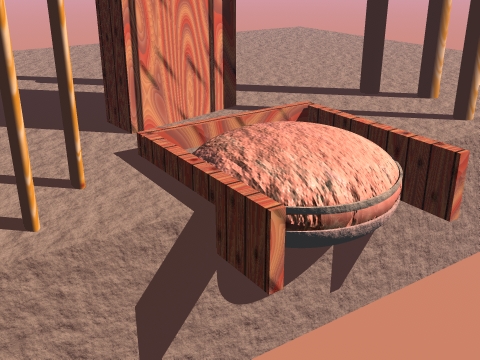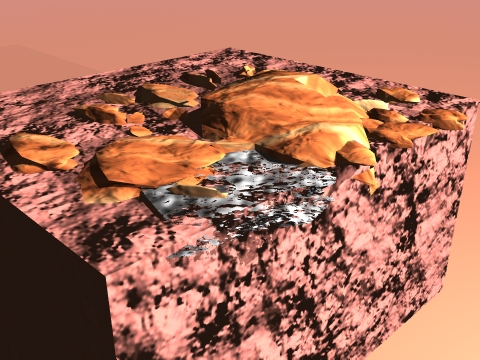The Virtual Meier Site
Hearth Features
 Hearths at Meier are very interesting. They are roughly a meter in diameter and are generally ovate in section view and circular in plan view. These hearths were rather formalized sources of heat, light and smoke; they were contained within squared, plank 'hearth boxes', which contained the fire and prevented it catching to the floor planks. Hearths were often sand-lined, with a layer of sand beneath the indurated, compact ash and countless fragments of burned bone which form the distinctive 'hearth domes'.
Hearths at Meier are very interesting. They are roughly a meter in diameter and are generally ovate in section view and circular in plan view. These hearths were rather formalized sources of heat, light and smoke; they were contained within squared, plank 'hearth boxes', which contained the fire and prevented it catching to the floor planks. Hearths were often sand-lined, with a layer of sand beneath the indurated, compact ash and countless fragments of burned bone which form the distinctive 'hearth domes'.
Five formalized hearths were found at Meier, running down the middle of the plankhouse and relatively evenly spaced. It is liklely that each of these large hearths was used by two families; one on each side of the plankhouse, flanking a given hearth. I note that this hypothesized arrangement would have preserved the strong edicts of noncontact between people of the higher and lower ranks, as people were likely arranged within the plankhouse with the lowest-ranked at one end, and the highest-ranked on the other end. This arrangement of family placement within the plankhouse according to social rank is common on the Northwest Coast. If we postulate a family size of six persons per family (two adults, one elder, two children and one slave), we may calculate a very rough, average population of the plakhouse as 12 people per hearth x 5 hearths = 70 people.
The Meier hearths are often 'stacked' atop one another. This represents the continual re-use of the hearth boxes, such that the hearth does not move around through time, on the plankhouse floor, as observed in somoe other Northwest Coast houses. Rather, in the Meier plankhouse, it appears that the central area of the structure was assigned to be the hearth area, and that this hearth area was somewhat inviolate. To me, this suggests a rigidity of 'spatial assignment' somewhat higher than that observed in many illustrations of Northwest coast plankhouse interiors. This may not be surprising, given that Chinookan society was strictly divided among class lines; those of elites, commoners and slaves. Rank was important, and it was communicated and reiterated in a number of ways, such as cranial deformation (flattening the heads of elite children during infancy) and spatial segregation of different social classes. See the section on 'Chinookan Society' for more information.

Hearth matrix is also found in non-hearth areas; in these areas, though, it is generally found in a disassociated state, scattered, appearing to be a dump of hearth matrix. The presence of such features in the midden units, as well as in exterior contexts, suggests periodic cleanout of the hearth bowls (described above). It appears that ash, charcoal and some sand, as well as fire-cracked rock, was periodically scooped up from hearth areas, and dumped in the midden, or at other extra-plankhouse areas. Some hearth dumps (illustrated above as amorphous but associated scatters of heath ash and sand) are found in pits in the plankhouse, near the hearth areas; hearths are not found near the benches. 'Destroyed hearths' are often found, near intact hearths, cut by postmolds and/or plankmolds.
Back to Features


